
* During World War II, the Glenn L. Martin company developed two flying boats, the "Mariner" and the giant "Mars". The Mariner would serve prominently in the conflict; the Mars would not prove so significant, but its sheer size gave it a prominent place in aviation history.
* Glenn L. Martin was one of the pioneers of American aviation. He was a Midwesterner who made a reputation as an aerial daredevil and then formed the "Glenn L. Martin Company" in 1911. Martin was energetic, bright, and competent, and the company did well, helped by top talent. He was also sour, humorless, and quarrelsome -- but that helped too in the greater scheme of things, since it motivated some of the top talent like Donald Douglas to go form their own companies.
The Martin company was initially best known for bombers, but in 1929 the US Navy ordered the "Model 117 PM-1" flying boat from Martin. This machine had actually had been designed by the Naval Aircraft Factory (NAF) company, and was in turn an evolution of a long series of flying boats that began with the Curtiss "America" machines that had been developed before the First World War -- which had led to the important British Felixstowe "F-5" flying boat of the immediate postwar period and its American Curtiss "F-5L" counterpart.
NAF had built the F-5L as the "PN-5", and refined the design up to the "PN-12", which featured metal construction and radial instead of inline engines. NAF didn't have production facilities to turn out the PN-12 in quantity, and so the Navy arranged its manufacture with Martin, Douglas (as the "PD"), Keystone (as the "PK"), and Hall (as the improved "PH" series). The Navy acquired a total of 27 Martin PM-1s, with three more passed on to the Brazilian Navy with the designation "PM-1B".
The PM-1 was a biplane, with a wingspan of 22.2 meters (72 feet 10 inches), a length of 14.9 meters (49 feet), an empty weight of 3,936 kilograms (8,680 pounds), and twin Wright R-1750D Cyclone radial engines with 394 kW (525 HP) each. The PM-1 was followed by 28 similar "Model 122 PM-2" flying boats, with twin tailfins and more powerful Wright R-1820-64 Cyclones with 430 kW (575 HP) each. The Navy added enclosed cockpits to some of the PM-2s. The Martin PM flying boats remained in service with the Navy into the mid-1930s, while some of the Hall-built PH flying boats served as coastal patrol machines with the US Coast Guard (USCG) well into World War II.
* In the meantime, Martin had been working on more ambitious flying boats. The Consolidated company had developed a long-range flying boat for the Navy, flying a prototype designated the "XPY-1 Admiral" in 1929. In an action that would cause so much protest and litigation as to be unthinkable today, the Naval Bureau of Aeronautics decided to initiate a competition for production of the Admiral, even though the Navy's funding to Consolidated for prototype development had not come close to covering Consolidated's actual development cost.
Glenn Martin disapproved of such unfair business practices, as would any businessman, but that didn't stop him from bidding on the deal. Martin, not having to bear the burden of prototype development, underbid Consolidated and was awarded a contract for nine machines, designated the "Model 120 P3M-1". The Navy passed the XPY-1 prototype on to Martin, but to absolutely no surprise Consolidated refused to provide Martin with engineering drawings and specifications, forcing Martin to reverse-engineer the machine. Martin also modified the prototype, making various changes, such as reducing the number of engines from three to two.
The nine P3M-1 machines were not delivered until 1931. The P3M-1 was a monoplane with a high strut-mounted wing and a twin tail. It had a wingspan of 30.5 meters (100 feet), a length of 18.8 meters (61 feet 9 inches), an empty weight of 4,530 kilograms (9,988 pounds), and twin Pratt & Whitney (P&W) R-1340-38 Wasp air-cooled radials with 335 kW (450 HP) each.
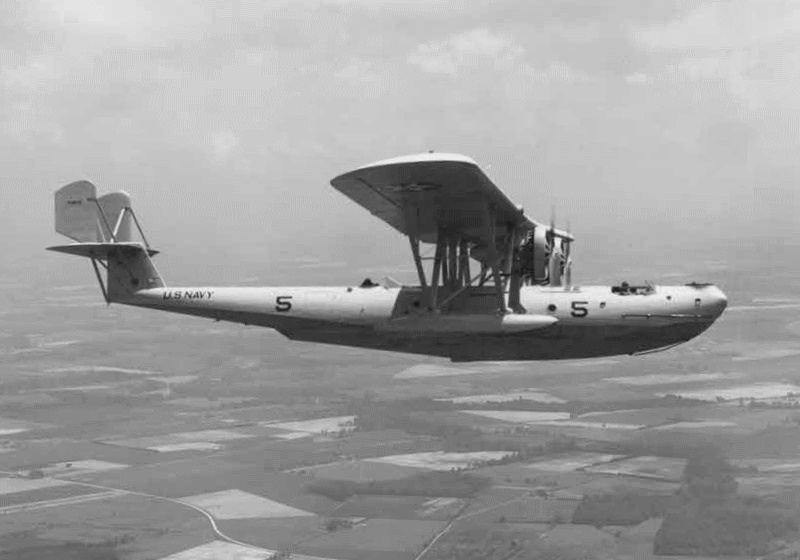
The P3M-1 was larger than the PM-1 and had less powerful engines, suggesting it was underpowered. That suggestion is reinforced by the fact that the P3M-1s were immediately withdrawn to be refitted with uprated P&W R-1690-32 Hornet radials with 390 kW (525 HP) each, and given the new designation of "P3M-2". They had a first-line service life of about a year, though a few remained in second-line service for several years.
Consolidated got some satisfaction out of the failure of the P3M, with the company's Reuben Fleet commenting that Martin "underbid us a half-million and lost a million on the job." Consolidated produced a successful commercial airliner version of the Admiral, the "Model 16 Commodore"; then came up with a successor military design, the "Model 22 / P2Y Ranger"; which in turn led to the "Model 28 / PBY Catalina", one of the most important flying boats of World War II.
* However much the P3M had been a loss for Martin, it had been a step forward in sophistication, and the company moved on to a much bigger, better, more modern aircraft, the "Martin Model 130 Clipper" flying boat, with transatlantic range. Pan American ordered three in 1934, with all three delivered in 1935. They were named "Hawaii Clipper", "Philippine Clipper", and "China Clipper".
The Martin 130 was spectacular for its time, much more modern than the Admiral, sleek and elegant by flying-boat standards. It was a high-wing monoplane, with a span of 39.6 meters (130 feet), a length of 27.7 meters (90 feet 10 inches), an empty weight of 11,502 kilograms (25,363 pounds), and was powered by four P&W R-1830-S2A5G Twin Wasp radial engines with 620 kW (830 HP) each.
Instead of outrigger floats, the Model 130 used a "sea wing" -- a short sponson under the main wing that provided stability on the sea, and also served as a fuel tank. The Model 130 had a maximum capacity of 48 passengers, though for long flights to, say, Hawaii, it had to carry so much fuel that it wasn't able to carry more than a dozen passengers.
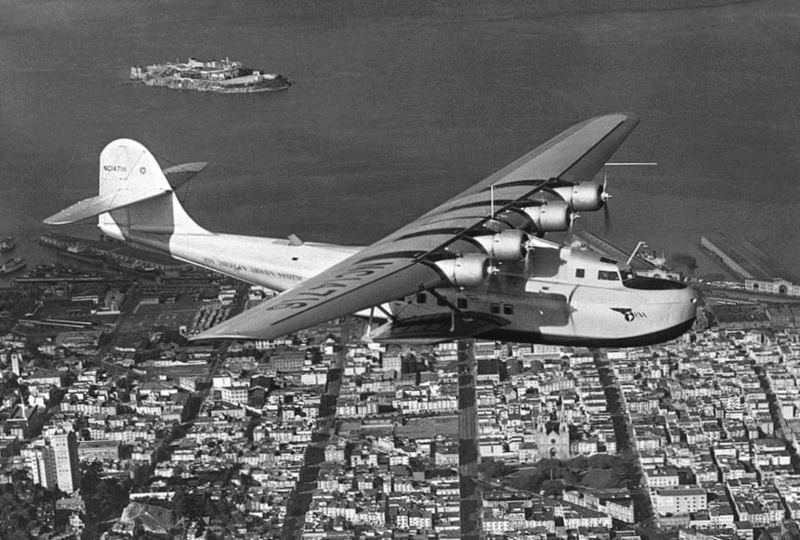
The Model 130 was an inspiring design but a commercial failure, and no more were built. There was a race to build bigger and better flying boats at the time and the Martin Clippers were outpaced by the competition, particularly the Boeing Model 314 Clipper. Martin had built the three Model 130s at a loss in expectation of more orders, and was forced to take a large write-off on them.
All three of the Model 130s came to bad ends. The Hawaii Clipper disappeared without a trace in July 1938 while on a flight from Guam to Manila. The two surviving aircraft were pressed into US Navy service in 1942. The Philippine Clipper flew into a mountain in 1943 while coming into San Francisco. The China Clipper went back into Pan Am service, flying the South Atlantic route, only to be wrecked in a botched landing off of Trinidad in January 1945.
Martin also designed a bigger version of the Model 130, the "Model 156", which was the same length but had a wider wingspan of 47.9 meters (157 feet), twin tailfins, and more powerful Wright R-1820-G2 Cyclones with 634 kW (850 HP) each. Only one was built, in 1937, to be delivered to the USSR in 1938. The Soviets paid a good price for the "Soviet Clipper", as it was named, and also paid for engineering specs and a license agreement. They never actually built the machine themselves, but they used the Soviet Clipper over the Soviet Far East until 1944, when it was finally scrapped.
* The Martin company's luck with flying boats during the 1930s was mixed, to put it mildly, and might have discouraged men less obstinate than Glenn L. Martin. However, he persisted, and would build new flying boats that would achieve many distinctions.
BACK_TO_TOP* Martin began work on an improved military flying boat in 1937. The US Navy wanted a new machine that would be superior to the Consolidated PBY Catalina, then the latest and greatest the Navy had, and in response Martin developed the "Model 162". On 30 June 1937, the Navy awarded Martin a contract to build a prototype of the Model 162, with the naval designation of "Experimental Patrol Bomber Martin 1 (XPBM-1)".
The Model 162 featured a deep hull and shoulder-mounted gull wings, with a flat twin-fin tail assembly, and wing floats that retracted inward. The gull wing kept the engines out of the ocean spray without use of a draggy parasol wing mount. The aircraft was to be powered by twin Wright R-2600-6 Cyclones with 1,195 kW (1,600 HP) each.
A 3/8ths-scale single-seat prototype designated the "Model 162A" was built to prove the design. The "Tadpole Clipper", as it was called, was powered by twin Chevrolet four-cylinder air-cooled engines with 90 kW (120 HP) each and driving the props with a vee belt drive. Test flights began in December 1937. The flying model proved very useful, and has survived to the present day as an exhibit in the Museum of Industry in Baltimore, Maryland.
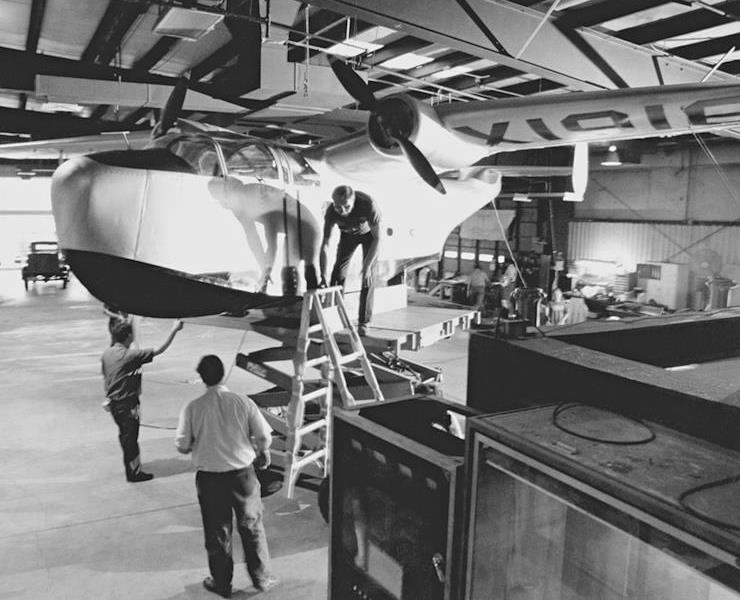
The XPBM-1 prototype first flew on 18 February 1939. It used three-bladed propellers and was initially unarmed, fitted only with dummy turrets. Flight tests showed that the prototype suffered from tail flutter, leading to the redesign of the tail assembly. The flat tailplane was changed to a distinctive dihedral configuration, whose angle matched that of the gull wings. The tailfins remained perpendicular to the tailplane, giving them an inward cant. The prototype remained in use for armament tests during the war under the designation of "XPBM-1A".

* On 18 December 1937, well before the flight of the XPBM-1, the Navy had placed an order for 20 production aircraft, to be designated "PBM-1". However, the Navy had by no means given up on the PBY Catalina, simultaneously ordering 33 "PBY-4s" with uprated engines. The Martin flying boat was a more advanced aircraft than the Catalina, but the PBM would not displace the PBY during World War II, and would historically end up in the Catalina's shadow.
Deliveries of the PBM-1 began in October 1940 and were completed by April 1941, with the total apparently reaching 21 instead of 20. The type was given the name "Mariner", in keeping with Martin's custom of giving their aircraft names starting with "M". The production PBM-1 was very similar to the XPBM-1, though it had a revised tail design and was of course fitted with full operational kit.
The PBM-1 featured a crew of seven and defensive armament of five 12.7-millimeter (0.50-caliber) Browning machine guns. One gun was mounted in a flexible position in the tail, with the gunner lying prone; one gun was fitted in a flexible-mounted beam position on each side of the rear fuselage; one gun was fitted in a rear dorsal turret; and one gun was fitted in a nose turret. A 20-millimeter cannon had been originally considered as an option for the nose turret, but was never fitted to any operational Mariner.
The PBM-1 could carry a total of up to 900 kilograms (2,000 pounds) of bombs or depth charges in bomb bays installed in the engine nacelles. The bomb bay doors looked like landing gear doors but the PBM-1 was strictly a flying boat, lacking undercarriage and requiring that beaching gear be attached to be brought up on land. Torpedo racks could be fitted under the wings inboard of the engine nacelles, and other stores apparently could be carried in the inboard position as well. Some sources also plausibly claim that a number of PBM-1s were refitted in the field with British-designed "Air to Surface Vessel Mark II (ASV.II)" longwave ocean-search radar, with "ladder" type transmitting antennas attached to the fuselage and a Yagi-style antenna under each wing.
Mariners immediately quickly found themselves operating in near-war conditions, as the US was expanding the range and scope of naval patrols to help protect shipments of material to Britain against German U-boats. These activities were ingeniously described as "neutrality patrols", intended to keep the US out of a European war -- though in practice they were effective violations of neutrality that antagonized Hitler, and whose details were concealed as much as possible from the American public.
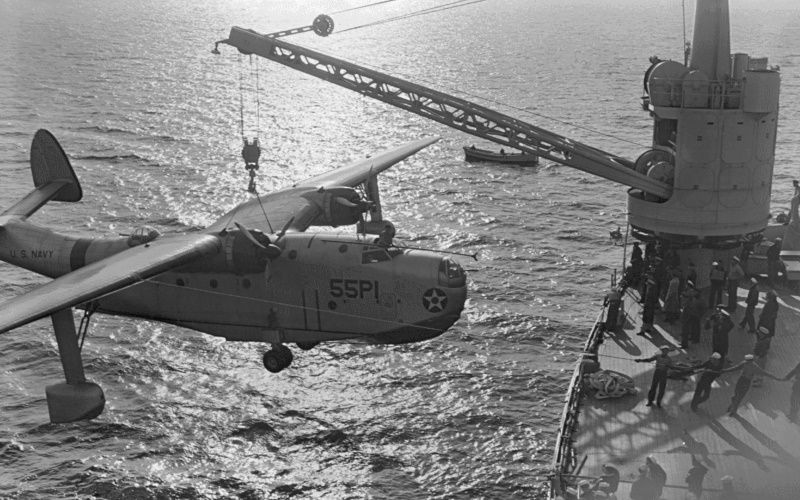
* A single PBM-1 was converted as a prototype of a long-range variant of the Mariner, designated the "XPBM-2". This machine featured additional fuel tanks that raised fuel capacity by over 75%, giving a range of 6,400 kilometers (4,000 miles). It was to be launched by a special catapult on a barge, with the Mariner's airframe reinforced to tolerate launch stresses. The catapult launch was successfully tested in 1942, but the idea was not followed up. The XPBM-2 remained in service as a test machine until 1944.
BACK_TO_TOP* The Navy was happy enough with their PBM-1s to order 379 improved "Model 162Bs" or "PBM-3s" in the fall of 1940, with the ultimate quantity being about twice that number. The government helped finance construction of a new Martin plant at Middle River, Maryland, to build the machines.
The initial PBM-3 was similar to the PBM-1 in most respects, differing mainly in fit of uprated Wright R-2600-12 Cyclones with 1,270 kW (1,700 HP) each; larger and fixed wing floats; and revised engine nacelles that featured much bigger bomb bays.
Other changes included new powered nose and dorsal turrets, both with a single 12.7-millimeter Browning machine gun; a proper powered tail turret, also with a single 12.7-millimeter Browning; and revised beam gun positions, eliminating the circular gun positions on each side of the PBM-1 in favor of a hatch with a flexible mount for a 12.7-millimeter Browning. Difficulties with the tail arrangement had persisted with the PBM-1, and so the PBM-3 featured small airfoils attached above and below the tailplane next to tailfins.
Although the first PBM-3s rolled out by Martin retained the three-bladed propeller, production quickly moved to a four-bladed propeller, which became standard. Some PBM-3s were also fitted with engine cooling fans.

* Only 32 PBM-3s as such were built, and they never saw formal service in their original configuration. 31 of them were converted to a transport configuration, the "PBM-3R", and 18 new-build PBM-3Rs were constructed as well. These machines had armor and armament removed, with the turrets faired over; a reinforced floor, cargo doors, and a hoist; and removeable seating for 20 passengers, though it was nothing unusual for them to carry 33 or more.
Deliveries began in the fall of 1942. Most PBM-3Rs served with the Naval Air Transport Service (NATS), where they were often flown by commercial pilots in Navy uniform. 12 were provided to the Royal Australian Air Force (RAAF) in 1943 and 1944.
* Another PBM-3 was modified as the "XPBM-3E" to test fit a new microwave AN/APS-15 radar in a big radome behind the cockpit. The AN/APS-15 had been originally built as a bomber targeting radar, known as "H2X", but when fitted with a different antenna it made a perfectly useful ASV radar.
The XPBM-3E led to the next major production subvariant, the "PBM-3C", with initial rollout in late 1942 and a total of 274 built. It featured greater crew armor protection, twin gun front and dorsal turrets, an improved tail turret that retained a single gun, and the ASV radar. A small number of early PBM-3Cs retained the single tail gun, and it seems that not all PBM-3Cs had the radar. Apparently many PBM-3Cs were fitted with an underwing searchlight in the field.
The PBM-3C saw plenty of action in the Caribbean, with the type assisting in 10 U-boat kills during 1942 and 1943. One famous PBM-3C, named the NICKEL BOAT, sank two U-boats, one on 17 May 1943 and the other on 19 July 1943. The twin-gun forward turret turned out to be particularly useful, since for a time U-boats were fitted with additional anti-aircraft guns and ordered to shoot it out with patrol planes. The forward "twin fifties" were an effective reply to this tactic -- which was quickly abandoned in any case, having proven a losing game for the U-boats.
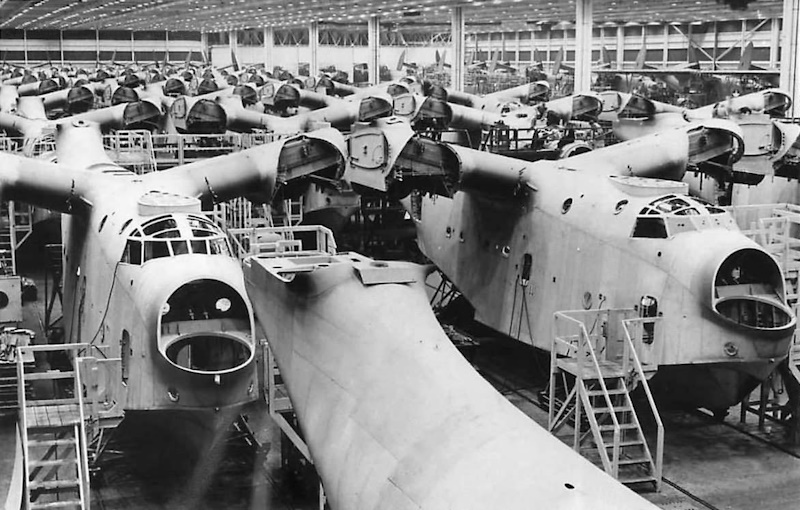
28 PBM-3Cs were supplied to the British as the "Mariner GR Mark I", the first of them arriving in August 1943, and deliveries complete by early 1944. They were painted in a natty color scheme, light gray on top and white over the rest. However, British evaluation of the type led to the conclusion that its controls were too heavy and tiring for long patrol flights, and the type never saw operational service with the British Royal Air Force (RAF) Coastal Command. Five were returned to the US, where they were given the designation "PBM-3B", and twelve were supplied to the RAAF.
* The extensive defensive armament of the Mariner was not really needed for western Atlantic patrols, since the type was unlikely to encounter much in the way of fighter opposition. That led to the decision to strip the PBM-3C of most of its armor and defensive armament, leading to the "PBM-3S".
The top turret was removed and faired over; the nose turret was replaced by a simple mount for twin Brownings; the tail gun installation was simplified but retained a single Browning; and one waist gun was removed, with the navigator sitting in the position occupied by the gunner. A handful of early machines retained the two-gun nose turret and the original PBM-3 tail gun configuration.
The reduction in weight apparently increased range by about 25%. The nose guns were clearly for suppressive fire against U-boats and other surface targets; they appear to have been on flexible mounts with a limited traverse, which would be logical, but some sources hint they were fixed.
The PBM-3S served exclusively or nearly so in the Atlantic, particularly in defense of the Panama Canal. They were often painted in a light-gray / white color scheme like that of the RAF Coastal Command, though there were variations. Most of the PBM-3S Mariners were fitted with engine cooling fans to deal with hot tropical climates. 94 were built new, possibly as production-line conversions of PBM-3Cs, and some PBM-3Cs were converted to PBM-3S standard in the field. 27 PBM-3S Mariners were transferred to the US Coast Guard (USCG), continuing in USCG service through the rest of the conflict.
* A single PBM-3C was modified with uprated Wright R-2600-22 Cyclones providing 1,420 kW (1,900 HP) and fitted with new four-bladed propellers, plus self-sealing fuel tanks, more crew armor, a Norden bombsight, and a twin-gun tail turret. AN/APS-15 radar was standard. The new configuration went into production as the "PBM-3D", with initial deliveries in late 1943 and a total of 259 production machines built.
___________________________________________________________________
MARTIN PBM-3D MARINER:
___________________________________________________________________
wingspan:
35.97 meters (118 feet)
wing area:
130.8 sq_meters (1,408 sq_feet)
length:
24.33 meters (79 feet 10 inches)
height:
8.38 meters (27 feet 6 inches)
empty weight:
15,050 kilograms (33,175 pounds)
max loaded weight:
26,300 kilograms (58,000 pounds)
maximum speed:
340 KPH (210 MPH / 185 KT)
service ceiling:
6,035 meters (19,800 feet)
range:
3,605 kilometers (2,240 MI / 1,950 NMI)
___________________________________________________________________
The uprated engines were welcome since the PBM had been regarded as underpowered, and helped raise the bombload of the PBM-3D to 3,630 kilograms (8,000 pounds). However, early production R-2600-22 engines had faulty valve seats, causing a string of engine failures until all the early engines were weeded out and replaced. The increase in weight of the PBM-3D also meant that the new engines didn't help as much as aircrews might have liked, and the PBM-3D's performance on a single engine was marginal at best.
The PBM-3D was able to participate in the invasion of Saipan in the spring of 1944. After Saipan's capture, the island became the primary US Navy seaplane base in the region, with Mariners and other flying boats operating from there participating in many later island campaigns.
* One PBM-3D had a remarkable adventure while it was being ferried over Arizona in the spring of 1944. The aircraft suffered an engine failure, and the pilot, Patrol Plane Commander Scott Fitzgerald, set it down neatly on Willcox Dry Lake, east of Tucson. The ground was smooth and Fitzgerald put the aircraft down neatly, causing some scraping to the hull but no significant damage. The Mariner was stripped down of all non-essential items, fitted with specially modified beaching gear, turned into the wind, and then took off from the dry lake bed, finally arriving in San Diego with no further trouble. The particular machine was from then on known as THE MIRAGE OF WILLCOX DRY LAKE.
BACK_TO_TOP* Navy brass recognized that the inadequate engine power of the Mariner was a problem and considered a "PBM-4" series that was to be powered by Wright R-3350-8 Cyclones with 2,015 kW (2,700 HP) each. Initial orders were placed in 1941, but then the allocation of the limited supply of the R-3350 engine became an issue and the PBM-4 orders were canceled.
The Navy eventually went to a "PBM-5" Mariner with more powerful P&W R-2800-34 Twin Wasps with 1,565 kW (2,100 HP) each. The engines were fitted in revised and lengthened cowlings and initially drove three-bladed Hamilton Standard props, later changed to four-bladed Curtiss props. The PBM-5 was fitted out for "jet (rocket) assisted take-off" (JATO / RATO). The configuration of the PBM-5 was otherwise similar to that of the PBM-3D, with the same defensive armament, armor, self-sealing fuel tanks, and AN/APS-15 radar.
Deliveries began in August 1944, with 589 delivered before the end of the war and the abrupt termination of production. The PBM-5 was a mainstay of Navy patrol squadrons in the last year of the war. Some were painted black for night operations, similar to the famous "Black Cat" Catalinas -- though the black Mariners were called "Nightmares", obviously as a contraction of "Night Mariners".

* There were a number of minor variations on the PBM-5, apparently all built as field conversions:
* The very last Mariner variant to be produced was the "PBM-5A", which was a PBM-5 fitted with tricycle landing gear for amphibious operation. The nose gear had twin wheels and retracted backward, while the main gear had single wheels and rotated up into the sides of the fuselage.
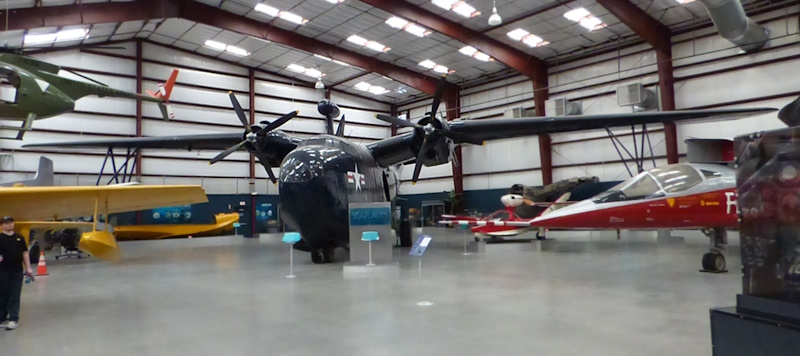
The "XPBM-5A" prototype was a modified PBM-5 and performed its initial flight in December 1947. 40 production PBM-5As were built, including 4 modified from PBM-5 Mariners and 36 built new. The last was built in April 1949. The production machines featured P&W R-2800-34 Twin Wasps, with reversible four-blade propellers to reduce landing roll, and most either had or were refitted with AN/APS-31 radar in a teardrop fairing. The Navy used the PBM-5A for ASW patrol, while the Coast Guard used them for SAR duties.
A total of 1,364 Mariners were built in all, variant production including:
* The Mariner served on with the US Navy and US Coast Guard into the early 1950s, with the type performing patrol and SAR duties during the Korean War. The USCG was the last US service to use the type, performing the last operational Mariner flight in 1958.

The Royal Netherlands Air Force operated 17 PBM-5As in the Dutch East Indies during the mid-1950s. During the 1950s, 3 PBM-5S2s were obtained to the Uruguayan Navy, while 8 Mariners were obtained by the Argentine Navy, with these aircraft lingering into the early to mid 1960s,
From 5 to 7 demilitarized Mariners were used by a Colombian air transport company in the late 1940s, but the company folded after a year or so in operation, and apparently a handful of Mariners flew with US civil companies as cargo haulers for a time. A handful of Mariners now survive as static displays, but none remain airworthy.
BACK_TO_TOP* US Navy interest in a very large flying boat, or "flying dreadnought", to be used for long-range ocean patrol, began in 1935, and resulted in a contract awarded to Martin on 23 August 1938. The new aircraft was designated the "XPB2M-1 Mars". The XPB2M-1 was rolled out from the hangar at Martin's Middle River, Maryland, plant in September 1941.
The "Old Lady", as it would come to be known, was a monster, something along the lines of a scaled-up four-engine Mariner. It had a wingspan of 61 meters (200 feet), a length of 36 meters (117 feet), and an empty weight of 34.3 tonnes (75,573 pounds). The aircraft was powered by four Wright 18-cylinder R-3350-18 Duplex Cyclone radial engines, each providing 1,490 kW (2,000 HP), driving three-bladed Schwarz wooden propellers with a diameter of 5.18 meters (17 feet).
The XPB2M-1 was unarmed, but had provisions for tail and nose turrets, a retractable top turret, and flexible gun positions on each side of the rear fuselage and under the rear hull. Each turret or gun position would mount a single 7.62-millimeter (0.30-caliber) Browning machine gun. The aircraft had a bomb bay in the fuselage, with stores shuttled out to doors in the wingroots.
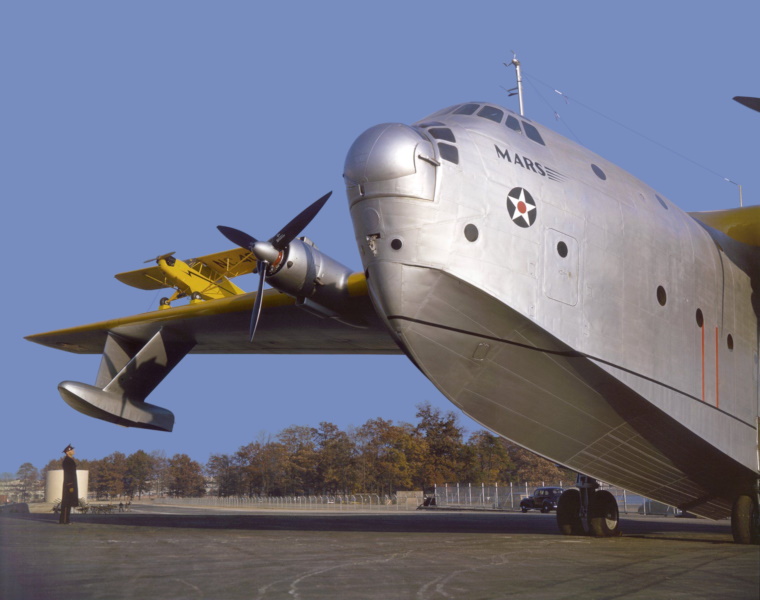
The Old Lady nearly came to grief during tests on 5 December 1941, when one of the engines caught fire. Fortunately, the engine burned off its mounts and fell into the water, preventing the destruction of the entire aircraft. The Old Lady made its first flight on 23 June 1942 (some sources claim 3 July 1942), after the engines had been replaced with uprated Duplex Cyclones with 1,640 kW (2,200 HP) each and driving three-bladed Hamilton Standard propellers with a diameter of 5 meters (16.5 feet).
Martin continued test flights on the aircraft until November 1943, when the Old Lady was passed on to the Navy. By this time the Navy had decided that big lumbering easy-kill patrol bombers were not such a good idea after all, and the flying boat was converted to a cargo aircraft before it was handed over. The provisions for turrets and guns, bomb bays, and armor plate were removed, cargo-loading hatches and cargo-loading equipment were installed, and the decking was reinforced. The modified aircraft given the designation "XPB2M-1R".
The XPB2M-1R operated in a training role out of the Naval Air Station (NAS) at Patuxent River, Maryland, until January 1944, when it was transferred to the Naval Air Station at Alameda, California. It made 78 round trips between San Francisco and Honolulu until being retired in March 1945. The Old Lady was then overhauled, to be used by Martin for training.
* The Navy was pleased enough with the Old Lady in its transport configuration that they decided to order 20 of a purpose-built transport version for the specific purpose of proving airlift services between Alameda and Honolulu. The new version was given the designation "JRM-1".
The first JRM-1, named the "Hawaii Mars", was completed in June 1945. The Hawaii Mars had the same wing and float structure as the Old Lady, but was otherwise extensively redesigned. The powerplants were upgraded to 1,790 kW (2,400 HP) Wright R-3350-8 Duplex Cyclone engines; the twin-tail was replaced by a tall single vertical tailfin; the fuselage was extended by 1.82 meters (6 feet); large cargo doors with electric hoists were installed under the wings with smaller cargo doors placed farther aft; and the internal layout was optimized for cargo and transport operations, with fewer internal bulkheads.
The JRM-1's maximum cargo capacity was almost 16 tonnes (35,000 pounds). The aircraft could be configured to carry 133 troops, or 84 litters (with 25 seats) for the medical evacuation ("medevac") role, on its two decks. Unfortunately, the Hawaii Mars was lost in an accident in Chesapeake Bay on 5 August 1945.
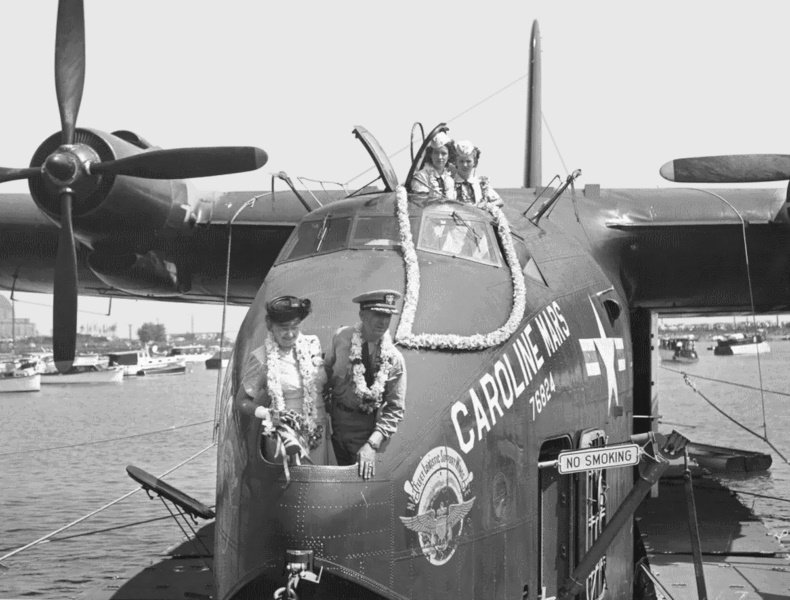
A few days later the war was over, and the Navy decided they didn't need 20 JRM-1's after all. Five more Mars flying boats were completed instead: the "Philippine Mars", the "Marianas Mars", the "Marshall Mars", a new "Hawaii Mars", and the single "JRM-2 Caroline Mars", delivered in July 1947 and equipped with 2,238 kW (3,000 HP) P&W R-4360-4T Wasp Major 28-cylinder four-row "corncob" radial engines.
___________________________________________________________________
MARTIN JRM-2 MARS:
___________________________________________________________________
wingspan:
61 meters (200 feet)
wing area:
342.3 sq_meters (3,683 sq_feet)
length:
35.7 meters (117 feet 3 inches)
height:
11.7 meters (38 feet 5 inches)
empty weight:
34,279 kilograms (75,573 pounds)
max loaded weight:
74,843 kilograms (165,000 pounds)
maximum speed:
356 KPH (221 MPH / 192 KT)
service ceiling:
4,450 meters (14,600 feet)
range:
7,958 kilometers (4,945 MI / 4,300 NMI)
___________________________________________________________________
The Marshall Mars was lost on 5 May 1950, off Diamond Head in Hawaii. One of her engines caught fire and though the pilot put her down on the water and a rescue crew on a boat tried to help, the fire spread and the aircraft destroyed itself in a spectacular explosion. Fortunately, there were no serious injuries in the incident.
All the four surviving aircraft were upgraded to the "JRM-3" standard by fitting them with Wright R-3350-24WA Duplex Cyclone engines, with 2,238 kW (3,000 HP) each, and reversible props on the inner pair of engines. The JRM-3s operated mostly on the San-Francisco-Honolulu run, and set a number of records for freight hauling. The Navy was very happy with them, finding them reliable and economical to operate.
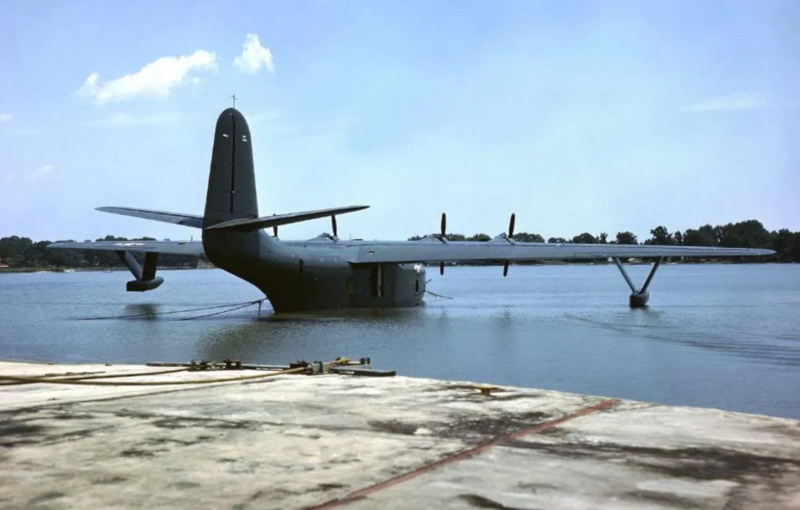
* The "Big Four" were retired in 1956. After being parked at NAS Alameda for three years, they were finally sold for scrap in 1959. However, that wasn't the end of the story.
In the late 1950s, the Canadian Pacific-coast province of British Columbia was badly hit by a series of forest fires, and in 1958 the lumber companies met to discuss what to do in response. One of the recommendations was to make greater use of "water bombers" -- aircraft converted to dump water on fires. Unfortunately, existing aircraft types used as water bombers, such as Beavers, Otters, Avengers and so on, couldn't carry enough water to really dowse a fire. A water-bomber pilot named Dan McIvor suggested that using surplus flying boats would give the fire-fighters the clout they needed. However, big flying boats were a thing of the past and most of them had been scrapped.
In the spring of 1959, McIvor learned that the US Navy intended to sell its huge Mars flying boats for scrap. McIvor knew that the Mars would be the best water bomber of all the aircraft he had considered, and called the Navy immediately. The bids had been closed, but the Navy gave McIvor the name of the winning bidder. McIvor called them and arranged to buy the four aircraft for a slight markup over their bid, paying the remarkably cheap sum of $100,000 US for all four. McIvor was apparently quite the energetic guy, as he then managed not only to acquire spare engines and the entire Navy parts stock and documentation archive for the archive for a small sum.
The four JRMs were flown to British Columbia during August and September 1959. The Caroline Mars was pressed into service for training, while the Marianas Mars was being converted into a water bomber by Fairey Aviation. All extraneous gear was stripped out, a single 22,700 liter (6,000 US gallon) fiberglass-plywood tank was installed, and two retractable scoops were built into the hull. New radio equipment and a spiffy red-and-white paint scheme completed the upgrade.
The Marianas Mars began its service in spring 1960. Unfortunately, McIvor ended up being grounded because of his eyesight, and his replacements weren't nearly as capable. On 23 June 1960, a pilot named Richman failed to heed the recommendations of an observer on a spotter aircraft and cartwheeled the Marianas Mars through the treetops, killing himself and the other three crewmen.
As a result, the conversion of the Caroline Mars to a water bomber was accelerated. In 1962 McIvor, who had got his license back on appeal, demonstrated the wisdom of his selection of the Mars flying boats by putting out a serious fire with the Caroline Mars before ground crews even managed to get to the scene. Unfortunately, the Caroline Mars was completely wrecked by a storm that winter.
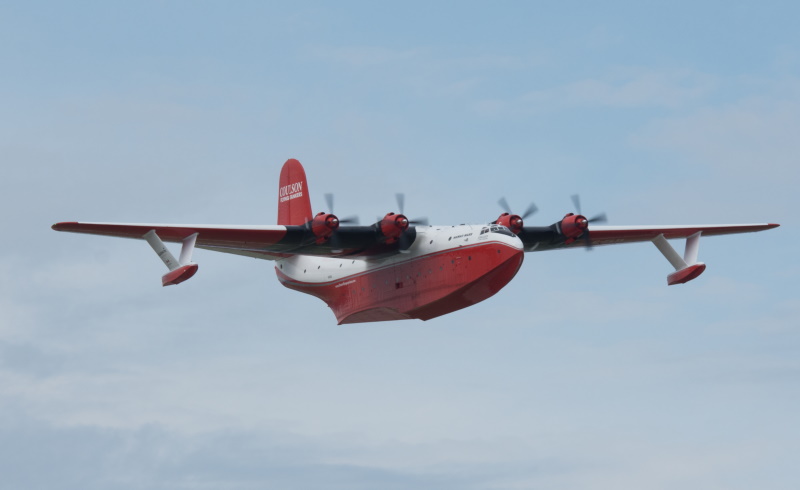
That left the Philippine Mars and the Hawaii Mars. Fairey Aviation immediately proceeded to convert them to water bombers as they had the other two aircraft. They also added a new secondary tank to contain "Gelgard", a thickening agent that was added to the water to make it viscous and not run off so quickly. The two water bombers went into service during the fire season in 1963. The Philippine Mars was retired in 2013, being put on display at the US Naval Air Museum in Pensacola, Florida. The Hawaii Mars was sidelined, and finally sold off in 2022, the buyer not being announced.
BACK_TO_TOP